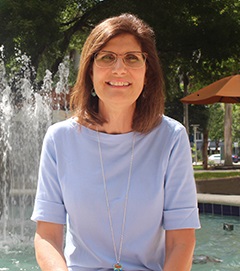From Pandemic to Endemic: the COVID-19 Evolution

First, the bad news: the virus that causes COVID-19 is here to stay, probably forever.
Now, the good news: it will probably become a milder, maybe even seasonal pathogen, much as influenza has turned out to be.
“COVID is not going to disappear,” says Dushyantha Jayaweera, M.D., FACP, an infectious disease researcher at the University of Miami Health System. “It will become endemic, with variants replacing the original version.”
This, he adds, should give hope to people who have been dealing with restrictions for more than a year.
“It won’t be something we can eradicate but something we can control. At some point, we will be able to return to a more normal life.”
– Dr. Dushyantha Jayaweera
How long that might take is tricky to predict, however. Getting from pandemic to endemic is not a straight line, and the journey will likely be littered with setbacks, from deadlier mutations to random outbreaks in demographic pockets that are unable or hesitant to be vaccinated.
“It depends on so many things,” explains Olveen Carrasquillo, M.D., MPH, chief of general internal medicine at UHealth. “How the vaccine rollout goes, how quickly we can achieve herd immunity, how effective vaccines are against the variants, how long immunity lasts. There are a lot of factors to consider.”
Under ideal conditions, with 70 to 80% of the public fully vaccinated and science developing booster shots in a timely fashion, we may achieve a semblance of normalcy by fall. Dr. Carrasquillo says he remains hopeful that the Thanksgiving-Christmas season will resemble those of the past. But we won’t be out of the woods, not by a long shot, until teens and children receive vaccinations and the rest of the world also reaches herd immunity.
If past viruses provide some clues, COVID-19 may one day be no more troubling than the flu.
This, however, isn’t a free pass nor a cause for celebration. “Influenza kills tens of thousands of people every year,” Dr. Carrasquillo adds. “It can be deadly. It still remains a threat.”
What’s more, while science has developed a proven treatment to lessen the severity of the flu, scientists are still researching comparable therapies for COVID-19. Monoclonal (lab-made) antibodies and steroids appear effective, as does the anti-viral Remdesivir, but the cytokine storm caused by SARS-CoV-2 is proving to be a dangerous challenge for the best treatments.
“We’re building the plane as we fly,” explains Dr. Jayaweera. “It’s a process.”
Since forewarned is forearmed, we asked Drs. Jayaweera and Carrasquillo to provide us with educated guesses about what we might expect both in the short and long runs – and what we, individually and as a community, can do to ease the passage to The New Normal:
COVID-19 in the short term
There will be a lot of stops and starts, encouraging numbers followed by disheartening statistics. As more people become fully inoculated and vaccines are approved for children, fewer people will get sick with the virus. Death rates will head downward, and hospitals won’t be overwhelmed by serious cases. We will approach the holy grail of herd immunity.
But getting there will be a tough slog. The current situation is a good example. Cases are down from previous peaks, but that trend has plateaued — and not at anything resembling a safe level, either. Comparing per-capita cases, U.S. “low” numbers are still higher than other countries. As a whole, we remain susceptible to surges, especially as the more infectious, and perhaps more deadly, variants take over.
Don’t stop washing your hands and wearing masks
“We cannot get too overconfident,” Dr. Jayaweera warns. “We cannot get complacent.”
Like other physician-scientists, Dr. Jayaweera, who led a local clinical trial for the recently approved Johnson & Johnson vaccine, worries that the public may let its collective guard down. Americans may think mask-wearing, social distancing, and hand-washing are not necessary as local and state governments rescind mandates.
In the short term, probably well into 2022, continuing the hygiene habits that stop the spread will be essential. Adds Dr. Carrasquillo: “This isn’t the time to stop doing all that. Even after you’re vaccinated, you might still be able to spread it.”
Adding to the concerns: variants keep cropping up around the world, and some are more transmissible as well as deadlier. One of those, the B.1.1.7, is expected to become the dominant strain in the U.S. later this month. There is, however, a ray of hope. Pharmaceutical companies are retooling their research to create potential boosters to combat the new threats.
Also, current shots appear to work against the severest expression of these variants. If a summer or fall surge driven by new variants does occur, as some virologists predict, the infections will likely be less severe if most of the public has been fully inoculated.
This is “More reason to get people vaccinated and to continue doing what we know works,” Dr. Carrasquillo says.
Vaccines key to long term recovery
Drs. Jayaweera and Carrasquillo are hopeful that the vaccines will usher in a return to travel, to schooldays in classrooms, to family gatherings, to concerts, to opening night at movie theaters — all those events and places that once gave us pleasure and a sense of community.
But this comes with a footnote: “We’re not going back to 2019,” Dr. Jayaweera warns. “I just don’t see that happening.”
We will need to remain vigilant, making sure to get booster shots and avoiding places prone to new variants – much as we do other diseases. Localized outbreaks and occasional waves will continue far into the future. Why? Vaccinations and infections probably won’t give us lifelong immunity.
Scientists, however, know that patients who get reinfected by similar viruses don’t go on to experience severe disease. So, under a best-case scenario, COVID-19 may eventually become like the four other seasonal coronaviruses that cause the pesky common cold. (Some are believed to have been circulating for centuries.) By the next decade, we may refer to winter as the cold-flu-and-coronavirus season.
Applying hard lessons to other pandemics
Drs. Jayaweera and Carrasquillo are also hopeful that the hard lessons we’ve learned during the COVID-19 crisis will be applied to future pandemics – and both are certain that another plague-like disease is not a matter of when but if.
“We have overcome all other past [health] threats by investing in our health system,” Dr. Jayaweera says. “And we need to continue.”
We have to support science and spend tax dollars on research.
Dr. Carrasquillo agrees. He hopes the U.S. continues to refine the health surveillance system that keeps track of viruses and pathogens as part of its investment in science. The pandemic has proven “how important leadership, especially government leadership, is in these times,” he adds. “I’m hoping we’ve learned that public health is critically important not just to a few but to all of us.”

Ana Veciana-Suarez, Guest Columnist
Ana is a regular contributor to the University of Miami Health System. She is a renowned journalist and author who has worked at The Miami Herald, The Miami News, and The Palm Beach Post. Visit her website at anavecianasuarez.com or follow @AnaVeciana on Twitter.
Tags: COVID-19, Dr. Olveen Carrasquillo, Dushyantha Jayaweera, endemic, pandemic, Vaccines
